Community nursing: tackling long-term effects of COVID-19 on older people living with frailty
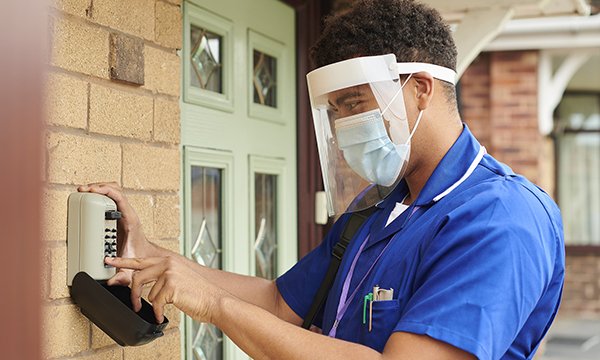
As community nursing services look to life after the pandemic, the focus is changing to keeping older people living with frailty safe at home and encouraging them to self-care
- District, community and practice nurses have taken on remote consultations and wearing personal protective equipment
- Older people living with frailty and affected by COVID-19 have become a significant part of the caseload
- But some older people supported to self-care at home have shown increased levels of confidence and independence
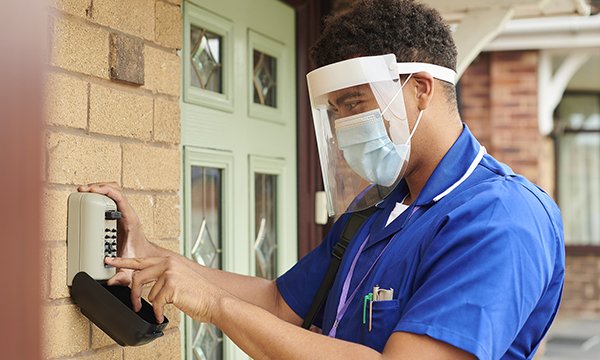
Older people living with frailty and affected by COVID-19 have become a significant part of the caseload of community nursing teams since the pandemic began last year.
District, community and practice nurses have continued to see these patients and have had to transform rapidly to meet new challenges – shifting to remote consultations in many cases – and working in personal protective equipment (PPE) over the past 18 months.
Midlands Partnership NHS Foundation Trust senior district nurse and clinical lead Lynn Sellwood says COVID-19 has tested community nursing in new ways.
‘Normally, as experienced nurses we know what to expect, how to deal with things and where to access support for patients. But with the pandemic everything was completely different. Yes, experience helps guide you in what to do, but everything just changed from the start of the first wave.’
‘A lot of nurses found it heartbreaking leaving people, knowing they are just desperate for human contact’
Lynn Sellwood, senior district nurse and clinical lead
Ms Sellwood, a Queen’s Nurse, is currently undertaking the Queen’s Nursing Institute (QNI) aspiring leader programme. As a community practice teacher she is responsible for mentoring specialist practice and district nurse students and nursing associate apprentices, as well as upskilling junior nursing staff.
She has been seeing patients at home throughout the pandemic, including managing older people with COVID-19 and also those affected by the disease although they did not contract it.
‘It affected people whose family couldn’t visit – they became very isolated and lonely, and we were the only contacts they had, so they wanted us to spend more time with them, which was difficult.
‘A lot of nurses found it heartbreaking leaving people, knowing they are just desperate for human contact.’
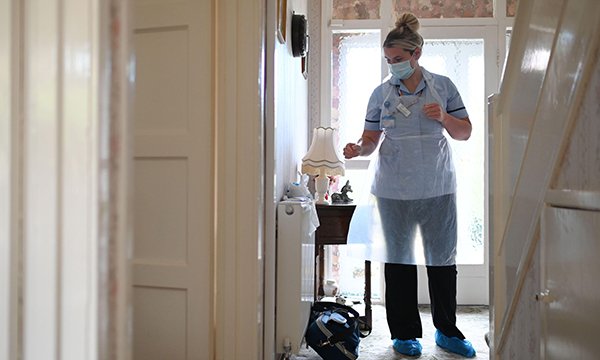
Ms Sellwood says managing older COVID-19 patients is still a challenge in terms of making sure they receive the right treatment and support at home as well as in dealing with the ongoing effects on health, even after apparent recovery.
While some will have been seriously ill and in hospital, even those with mild or virtually asymptomatic disease are experiencing lasting consequences. ‘There was a degree of deconditioning because they were exhausted and hadn’t been moving as much,’ she says.
A lot of people recovering from coronavirus had not been eating or drinking enough. ‘Most people I’ve spoken to who have had COVID-19 lose their appetites, and if you’re frail and elderly the last thing you need is not to be eating or drinking.’
Accessible patient information was of benefit in promoting rehabilitation
Her trust reacted quickly to this, producing patient information to try to promote rehabilitation. ‘We produced a leaflet during the first wave with advice on rehab and taking care of yourself after COVID-19. It was drawn up by the multidisciplinary team and we kept building on it throughout.’
As well as advice on keeping moving, eating and drinking, the leaflet had information on how to access food and who and when to contact services for further support.
‘That was beneficial,’ she says. ‘A lot of people you give leaflets to will just put them down, but they were keen to take advice so that they could get over it.’
Evidence of post-traumatic stress disorder and survivor syndrome
Managing older people who had been in hospital – sometimes seriously ill – with COVID-19 brought specific challenges. ‘Some had evidence of post-traumatic stress disorder and survivor syndrome,’ says Ms Sellwood.
‘Unfortunately my husband had respiratory failure in the first wave, and when patients were telling me what had been happening to them in hospital and what they had witnessed I could relate to them and tell them that what they were feeling was completely normal.’
Some patients were reluctant to allow anyone – even nurses – into their home, particularly in the early stages of the pandemic, she says. This had negative and positive consequences.
Number crunching: how the pandemic has affected health and well-being

Research published by the charity Age UK shows the pandemic has had a significant effect on the health and well-being of older people.
Age UK director Caroline Abrahams says there has been a toll on the mobility, confidence and capacity of older people to live independently without support after months of enforced isolation, inactivity and lack of stimulation.
A survey of more than 14,000 people aged over 60 in January and February 2021 revealed:
• 42% who had difficulty walking up and down stairs before the first lockdown in March 2020 reported that this had become more difficult
• 10% had difficulty walking up and down stairs when previously they did not
• 36% who previously had difficulty showering, having a bath or washing before the first lockdown said this had become worse
• 43% who had difficulty preparing and cooking food said it had become worse
Source: Age UK (2021)
The community nursing team were able to support people who chose to self-care, increasing levels of confidence and independence. ‘We made regular contact with them to make sure they were okay and didn’t feel alone with their care,’ says Ms Sellwood.
‘There’s been a lot of learning around people being able to self-care more, and that’s something we’ll take away from the pandemic.’
The nursing team also support carers – paid and informal – to help support patients. ‘We’ve involved carers in pressure ulcer prevention, for example,’ says Ms Sellwood. ‘We’ve given them documents about what to look for and when to contact us.’
Closures of hospital services put onus on enhanced community support
Less positively, some patients were reluctant to seek help even when they needed it. ‘That was a huge element,’ she says. ‘Some people didn’t want to contact us because of fear of COVID-19 or because they felt the NHS was stretched and they didn’t want to bother us – older generations often don’t like creating more pressure.
‘We’ve had a few incidents where people haven’t contacted us and it’s been detrimental to their health.’
In London, Park Medical Centre advanced nurse practitioner and partner Andrei Dunn says that the closures of some hospital services meant older people living with frailty and long-term conditions required enhanced community support.
‘The older generation were still getting ill but they couldn’t get to other appointments like hospital reviews,’ he says. ‘I was involved with a lot of the respiratory and cardiac patients, people with renal problems, with Parkinson’s disease – basically all the long-term conditions.
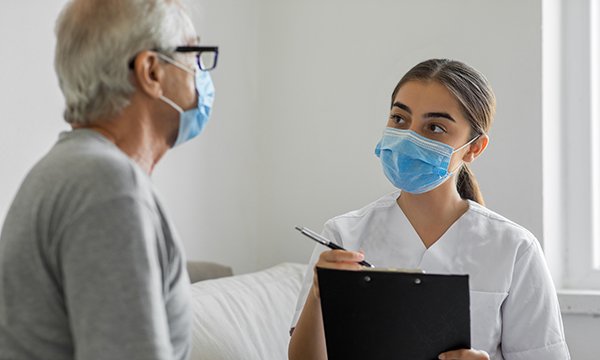
‘Then someone would present with the symptoms of an infection and it would turn out that they were COVID-19 positive, so we were looking after them as well.’
Practice treated people remotely where possible but ensured they were not digitally excluded
Mr Dunn and his nursing team were managing older people living with frailty who had COVID-19 at home. ‘If they were struggling we were having to review them and sometimes we had to send them back to hospital,’ he says.
‘We were also having to keep up to date with all the treatments recommended for long-term COVID-19 patients and continually review our policies. It was a lot of extra work in some ways. A lot of people thought we were closed – I had patients that I went to see on a home visit asking when we were opening again – but we never closed.’
The practice moved to treating people remotely wherever possible, and also took steps to ensure that patients were not digitally excluded. This involved delivering mobile phones and tablets donated by local businesses and community groups to people who needed them to access some health services.
‘We also had a local food delivery service – we have a social prescriber attached to the practice, and were able to identify people at risk who needed food parcels and things like that,’ says Mr Dunn.
Overall, his practice expanded its services to manage more acute illness in the community and to help the most vulnerable to stay at home where possible. But it was not easy, and there was the vaccine roll-out on top of that.
Rewarding to see the difference made to housebound patients or those self-isolating
They also had to pick up some of the tasks usually performed by the district nursing service, because some community nurses were redeployed into hospitals to help in the first wave. ‘We’ve been doing a bit more than we would normally in an attempt to try to meet what needs to be done,’ he says.
Ms Sellwood believes that despite the challenges of the pandemic there have been positive aspects.
‘At the end of the day we’re nurses and nurses get on with it. Yes it’s been tiring, and it has been hard work. But it’s been so rewarding in lots of aspects, seeing how much difference we can make either to the housebound patients or those who were self-isolating.’
Nurses will always go the extra mile, she says, whether popping out to buy bread and milk for someone to make sure they have access to food and drink, or reassuring them that they are being looked after.
There was also a sense of ‘pulling together’ among community teams. ‘Many boundaries were eroded, because everyone – nurses, healthcare assistants and nursing associates – all wanted to make sure that patients were safe, so we pulled together. It was lovely to see and be a part of.’
‘COVID-19 fundamentally changed the way we’re working’

Tim Hebbert is an advanced nurse practitioner and head of intermediate care and community with Your Health Partnership, a large, multisite practice part of the Sandwell and West Birmingham NHS Trust.
In an article in Nursing Older People in May 2020 that featured Mr Hebbert he described the speedy move to remote triage and consultations, access to personal protective equipment (PPE) and the need to provide high-quality end of life care for patients at home or in care homes.
‘What we’re doing now is a continuation of those changes,’ he says. ‘We’re still seeing people face to face but we have slightly better PPE and so we’re a bit better protected.’
Phone and video consultations are now embedded in practice. Before the pandemic his home visiting team had a ‘conversion’ rate of about 52% – meaning just over half of triaged calls resulted in a visit.
During the first lockdown that fell to about 17% and today it remains below 25%. ‘There was a dramatic shift and it’s fundamentally changed the way we’re working.’
‘You can work remotely much more confidently, knowing the decision you’re making is based on sound numbers’
As the pandemic progressed the team put in new measures to keep people safe at home and encourage self-care, including patients with a COVID-19 diagnosis.
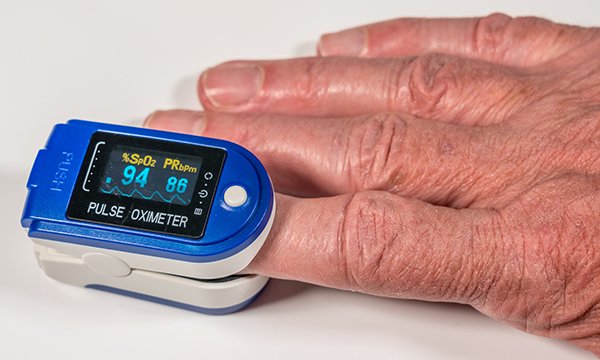
If they met specific criteria – including being over 65 and having a long-term condition or other risk factors – they would be given a pulse oximeter to measure their oxygen levels at home.
‘If patients were stable and not so ill that they needed to go to hospital we would give them a pulse oximeter and instructions on how to use it, then there would be a daily check-in call to see what their levels were.’
One patient, a long-distance lorry driver, had very low oxygen levels although he felt fine. ‘His levels were in the low 80s, which is way below the criteria for sending someone to hospital, but he followed the instructions, was admitted to hospital and was subsequently very unwell. Had he not gone to hospital at that time the outcome could have been very different, but his is a real success story.’
His practice is looking to expand the use of similar devices to aid remote care and self-management beyond the pandemic for the 15 care homes attached to the practice and for patients at home.
‘Having devices like that gives you more confidence in your decision-making skills, so you can work remotely much more confidently, knowing that the decision you’re making is based on sound numbers, backed with clinical judgement and experience and the patient’s story.’
Find out more
